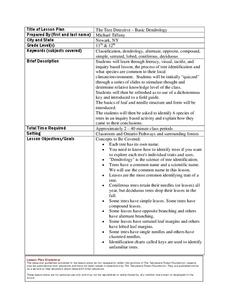Curated OER
Owen and Mzee
Students examine the trait of compassion. In this character education lesson plan, students read Owen and Mzee: The True Story of a Remarkable Friendship by Isabella Hatkoff. Students discuss the theme of the story as well as what it...
Curated OER
Name the Rests
Help your musicians learn rest counts and rhythm symbols with these 16 fill-in-the-blank questions. Questions ask learners to draw the matching rest symbol per given rest count. The next set of questions ask the opposite, the correct...
Illustrative Mathematics
What is a Trapezoid? (Part 1)
Challenge your class to construct a definition for trapezoids. Looking at four examples and four non-examples, students individually create definitions and use them to classify an unknown shape. Allow for small group and whole-class...
Oceanic Research Group
Heat Transfer and Cooling
Astronauts train underwater to simulate the change in gravity. An out-of-this-world unit includes three hands-on activities, one teacher demonstration, and a discussion related to some of the challenges astronauts face. Scholars apply...
Curated OER
Antonyms-- Matching Picture Clues
In this language arts worksheet, students explore antonyms and learn that they mean the opposite. Students read the words in 4 boxes and circle the antonym pair. They then draw a line to match the word with the picture it describes.
Curated OER
Youth Engagement
Learners examine and then discuss opposite sides of controversial issues such as neighborhood curfews, lowering voter age, etc. They learn civic responsibility and cultivate tolerance for others' opinions.
Curated OER
NEWTON'S 3RD LAW
High schoolers examine the formal definition of Newton's 3rd law: "forces always originate in pairs, equal in magnitude and opposite in direction." --The informal, qualitative version: "Each action has an equal and opposite reaction."
Curated OER
Rhytym in Interior Design
Learners demonstrate the use of rhythm in interior design. They create a sample page showing five different elements of rhythm as it is used in visual art. These elements include: repetition, gradation, transition,
opposition, and...
Curated OER
Rocket Science
Learners conduct an experiment. In this physical science lesson, students learn about Isaac Newton's theory that for every action there is an equal but opposite reaction. Learners show this theory by looking at how a rocket is propelled...
Curated OER
Dissolving Solids and Gases
In this dissolving solids and gases worksheet, high schoolers learn that the process of dissolving gas is opposite of the process of dissolving solids. Students answer 3 critical thinking questions about dissolving gases and solids in...
Curated OER
More About Static Electricity
Young scholars examine the concept that static electricity is a phenomenon that involves positive and negative charges. They explore the Static Electricity section of the Science, Technology and Engineering website to learn more about...
Curated OER
b or d: What do you see?
First graders often mix up the letters b/d, making them pronounce words incorrectly because they are identifying a b or d when they should be pronouncing the opposite letter. They are exposed to the two letters in a variety of ways...
Curated OER
Configuration Station #5
In this spelling and vocabulary learning exercise, students examine 5 words in a word bank. Students alphabetize, complete word puzzles, find the opposites, and illustrate. In this learning exercise 3 of the words studied are contractions.
Curated OER
World War I: War in a Democratic Society
Learners research opposition and support for World War I from a number of perspectives. They analyze a number of primary and secondary sources, while considering what (if anything) makes a war just and write a letter expressing his/her...
Math Mammoth
The Four Operations
In this order of operations worksheet, students complete several activities that help them learn to solve problems using the four operations of addition, subtraction, multiplication, and division.
Curated OER
Integrating Space Science-Ion Propulsion in Deep Space I
In this ion propulsion worksheet, students read about Deep Space I that uses ion propulsion to power the spacecraft. They learn about ion propulsion and answer three questions about it.
Curated OER
The Tree Detective - Basic Dendrology
Students identify tree species by their leaf characteristics. In this dendrology lesson, students learn leaf vocabulary and collect leaves. They identify the leaves using the leaf characteristics and the vocabulary that they learned.
Curated OER
Electric Charge
Students discover and identify positive and negative electrical charges and understand that like repels and opposite charges attract. In this physics lesson, students observe how friction can be used to give electrical charge to...
Curated OER
Them Bones
Students learn the correct names of various bones in the human body by using locomotor skills. They, in groups, move to the "pile of bones" to get the specified piece of the skeleton and the label required and return to the group.
Curated OER
Winter Olympics in the Gym
Young scholars develop their physical fitness while learning about some of the Winter Olympic Games.
Curated OER
Magnetism
Second graders conduct a variety of inquiry based learning activities. In this magnetism lesson, 2nd graders explore magnets with a partner, they learn the terms attract and repel, examine the poles of a magnet, and complete other...
Curated OER
Introduction to Puberty
Students describe some of the common external changes associated with puberty. They are introduced to the topic by stating that often these classes are called sex education classes. Students asked: what have you heard about these...
Curated OER
Phases of the Moon
In this moon phases worksheet, students learn about the different phases that the moon goes through. They then use the information the learned to answer the 9 questions in the packet. The answers are on the last page.
Curated OER
Synonyms and Antonyms
For this grammar worksheet, students learn about synonyms and antonyms. They then use what they learned to answer 30 questions. The answers are on the last page of the packet.

























